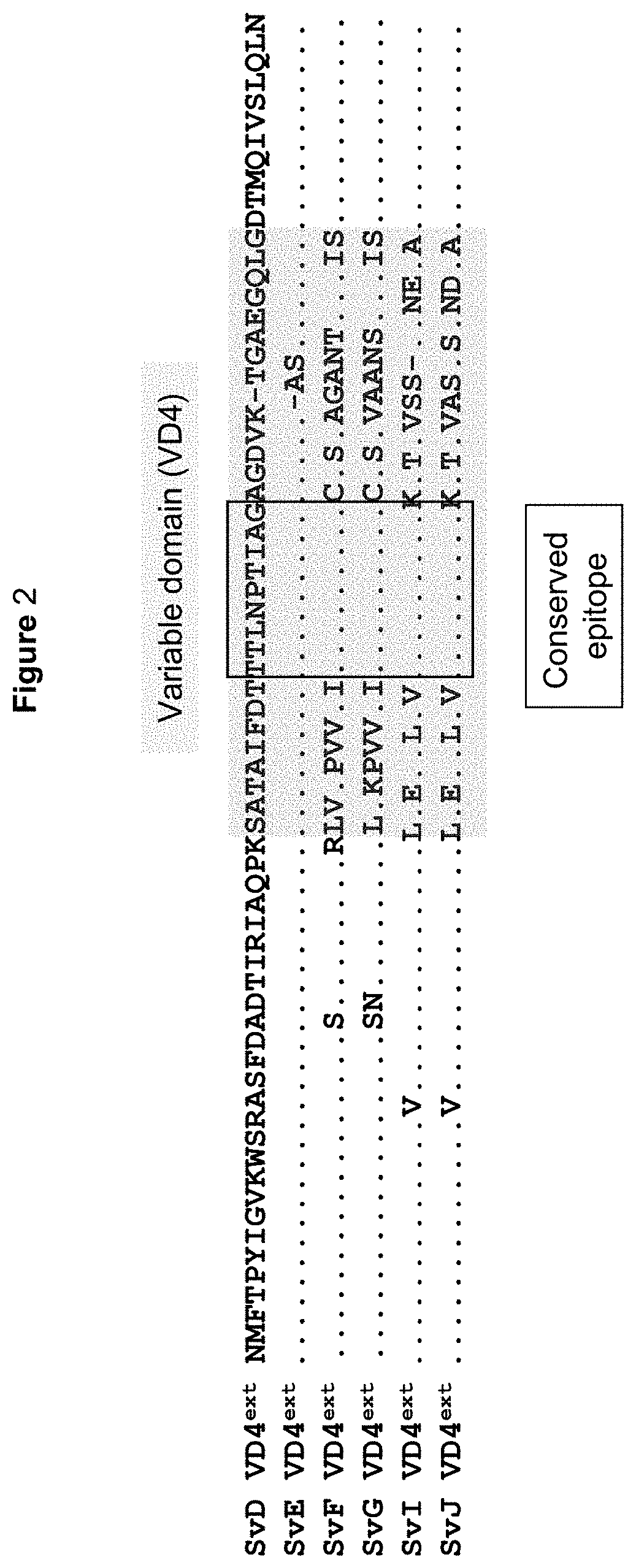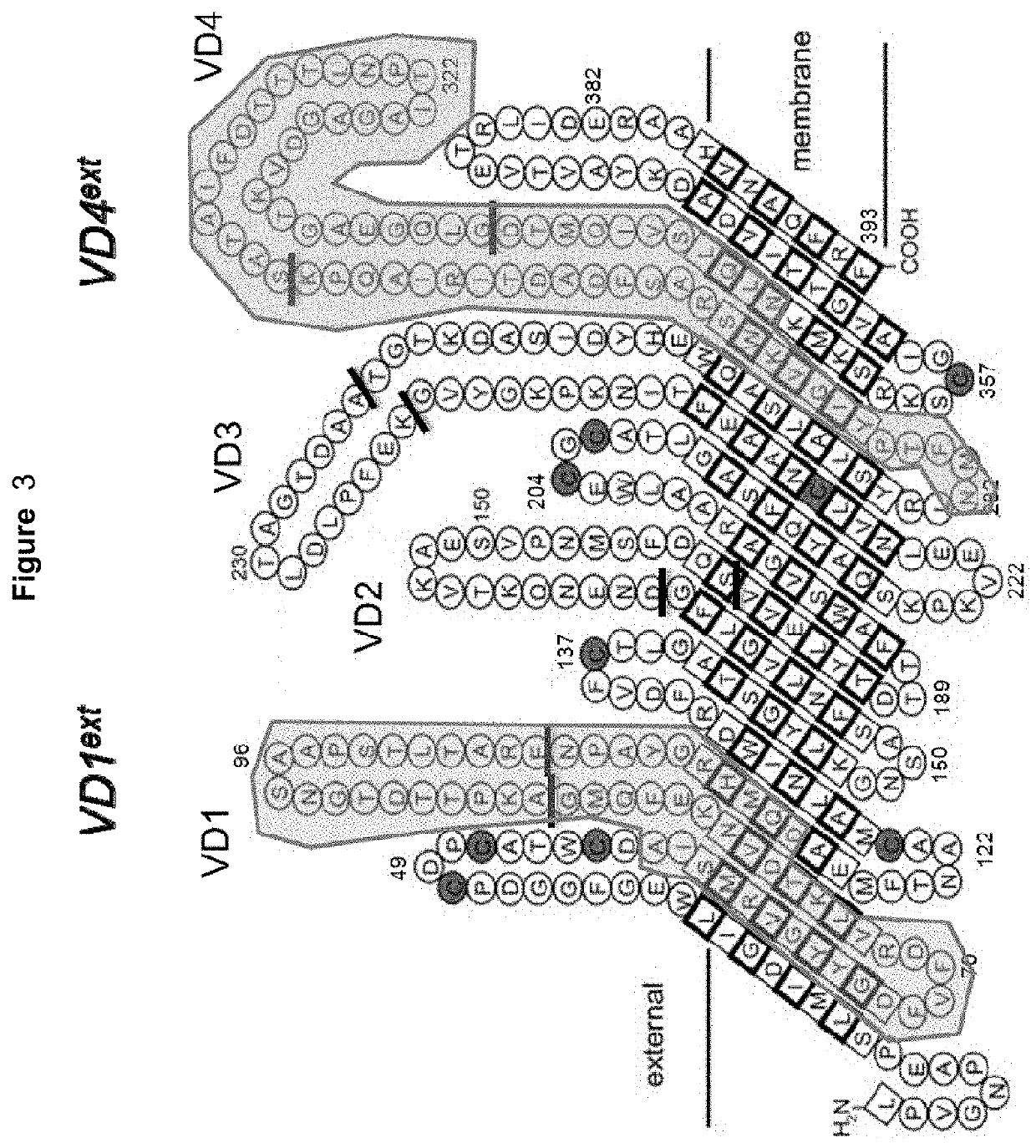Vaccines against Chlamydia sp
a technology of chlamydia and vaccines, applied in the field of vaccines against i > chlamydia /i > sp, can solve the problems of refolding various products to achieve the native protein structure, the structure of membrane bound cysteine rich molecule, and the inability to achieve sustainable disease control, etc., to achieve high surface binding and neutralizing antibodies, wide response, and high titers
- Summary
- Abstract
- Description
- Claims
- Application Information
AI Technical Summary
Benefits of technology
Problems solved by technology
Method used
Image
Examples
example 2
ct Composed of Heterologous Immuno-Repeats from SvD, E, F and G (CTH518) Induced a Stronger Response to Multiple Serovars Compared to Homologous Immuno-Repeats from SvF
Introduction
[0300]We investigated if immunization with at heterologous immuno-repeat composed of extended VD4 units from SvD, SvE, SvF and SvG (CTH518), maintained the strong immunogenicity and was able to induce a broader antibody response recognizing the surface of multiple serovars compared to immunization with a homologous immuno-repeat composed of extended VD4 units from SvF (SvF VD4ext)*4, (CTH529). These immuno-repeat constructs were formulated in the adjuvant CAF01 and used to vaccinate mice. The immunogenicity of the constructs was studied by ELISA against the bacterial surface of Serovar D, E and F.
[0301]Results
[0302]Heterologous immuno-repeats promoted an antibody response that recognized the surface of the serovar F strain at the same high level as the response seen with a homologous immuno-repeat from SvF...
example 4
ion with Heterologous Immuno-Repeats of Extended VD4's from SvD, SvE and SvF (CTH89) Generates Early T Cell Independent Protection after a SvD Challenge
Introduction
[0309]In order to study the effector mechanism responsible for the early protection seen after vaccination with the VD4 repetitive units, mice vaccinated with CTH89 were T cell depleted before challenge and the capacity to induce early protection was compared in depleted and non-depleted mice.
[0310]Results
[0311]Eight mice / group were immunized 3 times with 14 days between immunizations. The vaccine (2×5 μg) was emulsified in CAF01 and administered simultaneously by the sc. and i.n routes. At certain time points post last vaccination the mice were bleed and antibody responses against chlamydia, the neutralization titer, and in vivo protection with and without T cell depletion were measured. Depletion of the T cell subset eliminated the T cell response to CTH89 (FIG. 8A). CTH89 induced a strong antibody response (FIG. 8B) th...
example 5
eutralization with CTH89 Specific Serum
Introduction
[0313]In order to investigate if the in vitro neutralization could be translated to a protective effect mediated by serum in vivo, we next investigated if SvD bacteria coated with antibodies generated after CTH89 immunization could neutralize / inhibit the infection in vivo compared to serum from naive mice.
[0314]Results
[0315]SvD bacteria were mixed with serum isolated from CTH89 immunized mice or serum isolated from naive mice. Depro-provera treated mice were then infected with 4×105 bacteria. Mice infected with SvD coated with CTH89 serum efficiently controlled bacterial replication compared to mice challenged with SvD coated with naive serum. Six out of 8 mice were cleared at day 7 and 10 compared to 2 and 3 respectively, in the control group (FIG. 9).
Conclusion
[0316]Serum generated after immunization with heterologous VD4 immuno-repeat efficiently block infection of mice with SvD compared to serum isolated from naive mice
PUM
 Login to View More
Login to View More Abstract
Description
Claims
Application Information
 Login to View More
Login to View More - R&D
- Intellectual Property
- Life Sciences
- Materials
- Tech Scout
- Unparalleled Data Quality
- Higher Quality Content
- 60% Fewer Hallucinations
Browse by: Latest US Patents, China's latest patents, Technical Efficacy Thesaurus, Application Domain, Technology Topic, Popular Technical Reports.
© 2025 PatSnap. All rights reserved.Legal|Privacy policy|Modern Slavery Act Transparency Statement|Sitemap|About US| Contact US: help@patsnap.com



